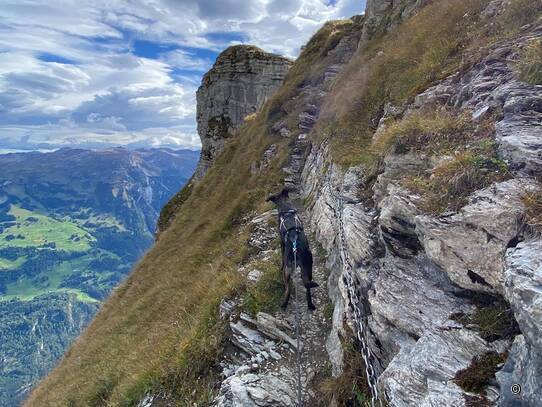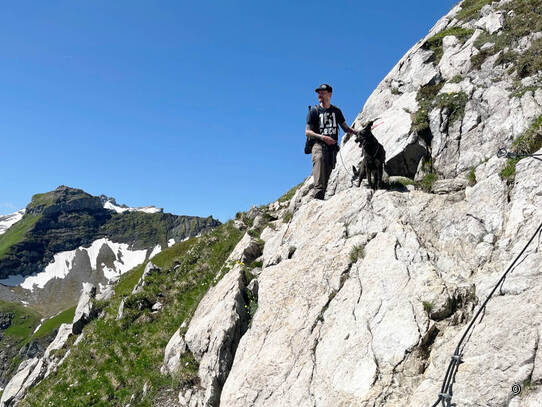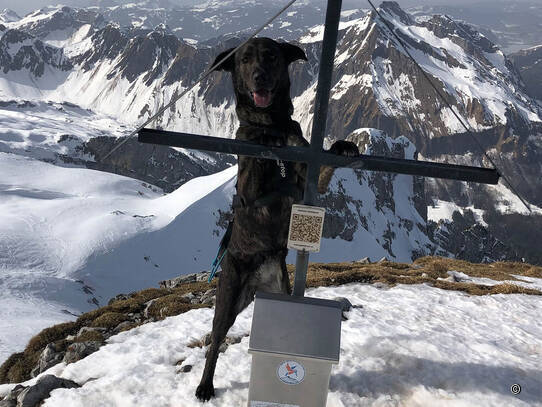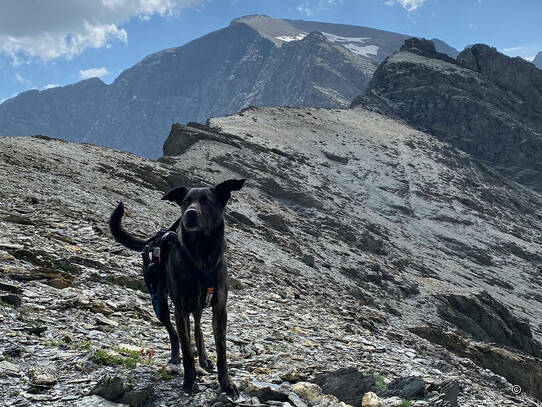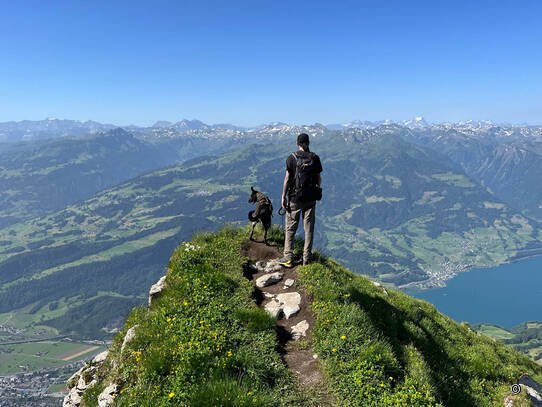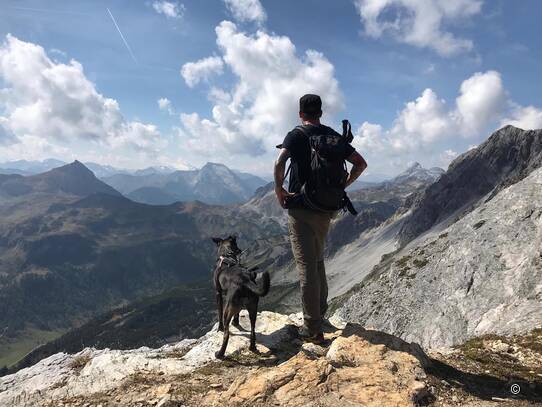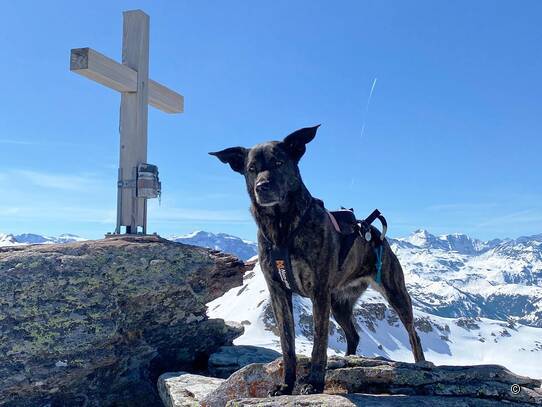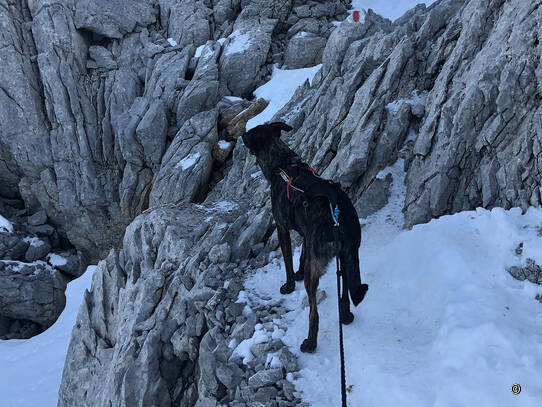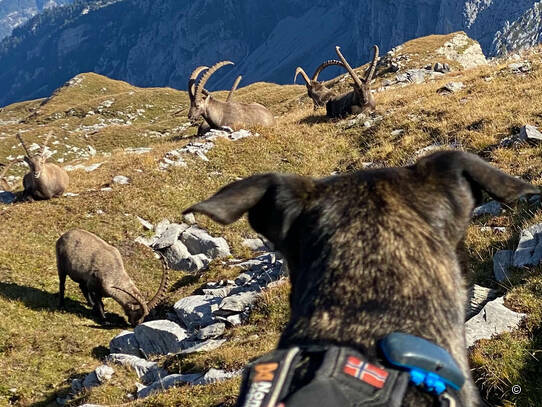Mountain hiking with dog
Report Fabian Schwander/24.08.2022:
Since mountain hikes are becoming more and more popular, which unfortunately more and more often ends in tragic accidents, Livia from H-UND asked me if I would like to write something about it. I am regularly with my Bardino lady on mountain or alpine trails, which makes me now definitely not an expert, but hopefully I can give the one or the other dog owner a few tips.
Accidents happen all the time, be it due to wrong or unsuitable equipment, poor planning, overestimating oneself, or simply because something goes wrong. Even the most experienced alpinists with the best equipment can crash. We can never completely avoid the risk of accidents in the mountains, as in many other areas, but we can reduce it to a minimum, partly just by being aware of it.
Basically, two topics are equally relevant to a successful mountain hike, namely planning and equipment. I would like to go into these two topics in more detail. It doesn't really matter where I start, since one is necessarily dependent on the other. So I proceed chronologically and start with the - often very time-consuming and underestimated.
PLANNING.
The first thing I think about is what I want to do. Personally, I currently have about 140 hikes of all lengths and elevations planned on my hiking app. Since I am experienced, I know exactly what is feasible for me and Alma, how many kilometers and meters of altitude we can tackle without hesitation and how long we will be on the road. If there are other hikers with us, we have to agree together. The rule of thumb says 15 minutes per 100 hm uphill (200 hm downhill) plus 15 minutes per kilometer distance. I think this is a good formula for beginners, but experienced hikers have their own individual calculations. You have to learn how to assess yourself when hiking, so be sure to start with smaller tours and then increase. Which route exactly I want to do, I usually decide one or two days before, when I can estimate the weather and my current daily form. If I have slept badly the last 3 nights, I do not plan 2000 meters of altitude with an alpine trail, because endurance and surefootedness depend directly on my own well-being. Tired legs, as is well known, do not always do exactly what they should, which can end fatally depending on the section. Also the head must be fully on the job, unfocused traverse difficult passages is not a good idea. In addition, hiking should also be fun, this is in a bad plan quickly times over and it is only completely annoyed and powerless trying to finally reach this stupid summit. With it neither humans nor dog is helped. I also look at the direction of the hike and plan with a round hike the steeper distance i.d.R. for the ascent. For tours where I am unsure if I can manage the distance or altitude, I see if the route can be changed spontaneously. On most hikes this is possible, on others there may even be a gondola that can be used if I am not as fit as expected.
ESTIMATION.
Apart from myself and Alma, I must also be able to assess the route. What difficulty (according to the SAC scale) can I expect? Is there a ladder on the way? Do I have to climb? What are the dangerous key points? You can rarely be completely sure, especially on alpine, unknown routes. But in the 21st century there are fortunately a variety of ways to get the best possible information, most easily via hiking sites and forums, Google or YouTube. Since everyone must be honest with themselves, whether it is feasible for dog and man. Personally, I like to look at critical places on the spot and decide spontaneously whether we can do it. If I am unsure, have a bad gut feeling or notice that Alma is overwhelmed, we turn around. But I already take that into account in the planning and often have a plan B ready here, too, so that we don't have to drive a long distance completely in vain. To break off a hike is in my opinion never a question of strength or weakness, but of reason. The highest priority must ALWAYS be that man and dog arrive back home in the evening! Since we are just at this point, it is very important to tell anyone where and how long the tour goes approximately, if this is done alone.
Otherwise, when planning, of course, the known factors to consider such as weather and temperature, with dog I still look at the map how much shade the tour offers and after drinking possibilities for Alma, then also depends on the water supply, which I must carry.
EQUIPMENT.
As important as good tires for the car are good shoes in the mountains. I do not drive in the winter for understandable reasons with summer tires around, just as little I go with Flipflops on the mountain. When it comes to shoes, almost everyone has their own views. But stable support and a good tread are indispensable for safety. Which shoes are the right choice depends on the trail and the conditions, and they also have to fit well and be comfortable. Personally, I am often overdressed in this point, because I usually wear the same shoes, that is, on a simple mountain trail the same shoes as on a glacier traverse or on a via ferrata. I recommend high shoes in the mountains, which protect the ankles and give some protection in case the foot bends away. In my opinion, it makes a lot of sense for a mountain boot to have a locking eyelet, which allows the boot to be laced more precisely at the top and bottom (instep and shaft). Meanwhile, there are such light mountain boots that the difference in weight compared to normal medium or high hiking boots is hardly worth mentioning. Price is of course different, but good quality hiking boots start in my experience so at 80.-. I see hiking boots (like car tires) as an investment, which is worthwhile. From the feet up it should be adapted to the weather.
Since this can change very quickly, especially in the mountains, belongs in every backpack at least a fleece sweater, better a real wind or rain jacket. For me, a thin cap and light gloves are always included, which I was glad to have even at the height of summer. Sticks and a good backpack are also recommended.
In addition to clothing, a 1st aid kit, emergency blanket, enough water, bowl and provisions belong to the basic equipment for every mountain hike. Do not forget food for the dog, as it burns significantly more calories during a mountain hike than in everyday life. Alma gets per hike in addition to the normal food about 200-250g very fatty food (self-cooked by my better half). For Alma I have of course all sorts of things in the 1st aid kit, most important are booties for the paws. There are many different, we have some for too sharp ground or injuries, some for long tours in the snow and breathable for hot asphalt. Also against allergic reactions (e.g. by insect bites) or a poisoning one should be prepared on tours of several hours.
Since our little mountain goat is almost unstoppable when hiking, we are always on the road with a belly belt, bungee cord and a traction or trekking harness. A safety harness has also been used, but that is not ideal for a dog that pulls like Alma. I would clearly advise against collars or Norwegian harnesses, as both are harmful to the dog when pulling. Optionally, I can still advise a GPS tracker, this is with Alma in the mountains always on, even if fortunately never used.
The equipment will of course vary with many mountain dog lovers. A light dog may need sunscreen, a small dog a harness with handle to help him up or down if necessary. Who goes with dog over fixed rope routes, should be able to carry this surely on the back, etc. etc.. With beginners, it will only gradually become clear what makes sense and what does not, but in my opinion, the basic equipment should look similar everywhere.
I hope that I could help with a few tips or even make the next mountain tour a little easier.
Fäbu & Alma (adventures of us you can also find on FACEBOOK or INSTAGRAM)





